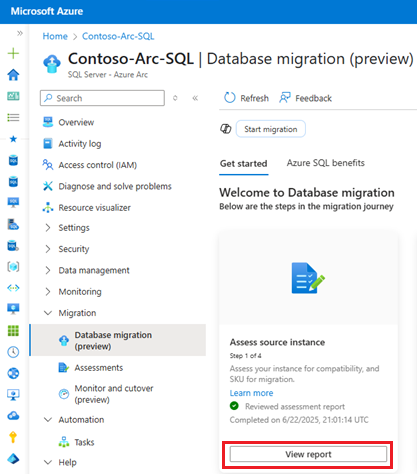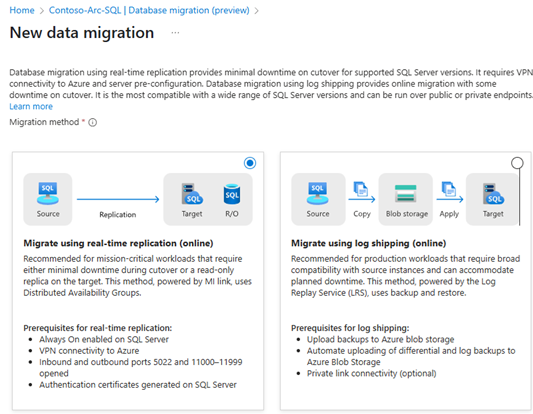Note
Access to this page requires authorization. You can try signing in or changing directories.
Access to this page requires authorization. You can try changing directories.
Applies to:
SQL Server
This article demonstrates how to migrate your SQL Server instance enabled by Azure Arc to Azure SQL Managed Instance in the Azure portal.
Note
Database migration to Azure SQL Managed Instance through the Azure portal is currently in preview.
Overview
SQL Managed Instance is a fully managed lift-and-shift, platform as a service (PaaS) target to run your SQL Server workloads in the Azure cloud platform. After your SQL Server instance is enabled by Azure Arc, you can assess your SQL Server data estate to identify an optimal SQL Managed Instance configuration. Then you can migrate your SQL Server databases to SQL Managed Instance directly from the Azure portal.
When your SQL Server instance is enabled by Azure Arc, you can:
- Evaluate and assess whether your SQL Server instance is ready to migrate to SQL Managed Instance.
- Identify potential migration risks, and learn how to mitigate them.
- Optimize for performance and cost with guidance around service tiers, configuration, and sizing.
Discovery of SQL Server instances and generation of readiness reports happen instantly, automatically, and continuously. No extra configuration or setup is required. First, you choose an appropriate SQL Managed Instance target and prepare your environment. Then, you can migrate your SQL Server databases to SQL Managed Instance directly from the Azure portal through a fully managed and automated process.
Database migration (preview) is available by default for all SQL Server instances enabled by Azure Arc, starting with SQL Server 2012 (11.x).
Choose the integrated migration method
You can choose the migration method that best fits your needs on the Database migration (preview) pane. After some initial configuration, migration is automated for you based on your selection.
The following methods are built into the migration process:
- Managed Instance link: Migrate by using real-time replication with a distributed availability group (online).
- Log Replay Service (LRS): Migrate by using log shipping (online).
To understand the differences between the two migration options, see Compare the Managed Instance link with LRS for migration. On the Database migration (preview) pane in the Azure portal, you can choose the option that best suits your needs in the Migrate data step.
Prerequisites
To migrate your SQL Server instance to SQL Managed Instance through the Azure portal, your instance must meet the following prerequisites:
- Be enabled by Azure Arc.
- Have Azure extension for SQL Server version 1.1.3106.305 or later.
The requirements for the source SQL Server instance depend on the migration method that you plan to use. For example:
- The Managed Instance link supports SQL Server 2016 and later on any supported edition of Windows Server.
- LRS supports SQL Server 2008 and later on any supported edition of Windows Server.
Permissions
This section describes the permissions that you need to migrate your SQL Server instance to SQL Managed Instance through the Azure portal.
On the source SQL Server instance, you need the following permissions:
- If you enable least privilege, necessary permissions such as
sysadminare granted as needed during the database migration process. - If you can't use least privilege, you need
sysadminpermissions on the source SQL Server instance.
To migrate with the Managed Instance link, you need one of the following permissions on the SQL Managed Instance target:
- SQL Managed Instance Contributor role
- Subscription-level Contributor or Owner role
For minimum permissions, see Custom permissions.
Note
Users with the SqlServerAvailabilityGroups_CreateManagedInstanceLink, SqlServerAvailabilityGroups_failoverMiLink, and SqlServerAvailabilityGroups_deleteMiLink permissions in Azure can perform actions on the Database migration (preview) pane during the migration process that elevate the SQL Server permissions of the account used by the extension, including the sysadmin role.
Prepare the environment for migration
To migrate your databases by using either the Managed Instance link or LRS, first prepare your environment.
To use the Managed Instance link, follow these steps:
- Set your SQL Server database to full recovery mode, and perform a recent full backup of your database. For SQL Server instances that meet the licensing requirement, you can enable the automated backups (preview) feature, which automatically determines backup qualifications. SQL Server instances that don't support the automated backup feature can still migrate their database through the Managed Instance link. You must manually validate that the database is in full recovery mode and perform a current full backup.
- Prepare your environment.
- Establish trust between instances.
Migrate to SQL Managed Instance
The following tiles guide you through the migration of your SQL Server databases to SQL Managed Instance:
- Assess source instance: Assess your SQL Server instance to determine its readiness to migrate to SQL Managed Instance.
- Select target: Select a SQL Managed Instance target for your migration.
- Migrate data: Migrate your SQL Server databases to SQL Managed Instance.
- Monitor and cutover: Monitor the migration process and cut over to the SQL Managed Instance target.
The following screenshot shows the tiles on the Database migration (preview) pane for your SQL Server instance in the Azure portal:
Assess source instance
To assess the source instance, follow these steps:
Go to your SQL Server instance in the Azure portal.
Under Migration, select Database migration (preview) to open the Database migration (preview) pane. Under Assess source instance, select View report to open the Assessments pane.

On the Assessments pane:
- Use Run assessment to initiate a new assessment if one wasn't run recently.
- Use View assessment details in the Azure SQL MI Recommended Target box to learn more about your assessment results, including the readiness of your SQL Server instance to migrate to SQL Managed Instance. You also learn about the recommended service tier and configuration for your target instance.
Select target
After you assess your SQL Server instance, select a SQL Managed Instance target.
On the Assessments pane, select Create target to open the Create or select target pane and identify a migration target.

On the Create or select target pane, under Target exists, select one of the following options:
- Yes, I have already created a target: Select an existing SQL Managed Instance target.
- No, I want to create a new target: Create a new SQL Managed Instance target.

Fill in the required information for the SQL Managed Instance target. Then use either Select target or Create target to proceed to the next step based on your Target exists selection.
- If you already have an instance as a target, choosing Select target takes you to the Database migration (preview) pane for your SQL Server instance. The instance name is populated as the selected target. Then you can proceed to the Migrate data step.
- If you chose to create a new instance, you're guided to the Create Azure SQL Managed Instance pane on the Database migration (preview) pane to create the target instance. After you finish, check the progress of the deployment on the Database migration (preview) pane for your SQL Server instance. The target name populates in the Target tile. Then you can proceed to the Migrate data step.
Migrate data
After your target is ready, start the migration process.
On the Database migration (preview) pane, select Migrate data.
On the New data migration pane, choose the migration option that suits your business needs, and then use Select to proceed to the next pane:
- Managed Instance link: Use Migrate using real-time replication (online)
- LRS: Use Migrate using log shipping (online)

If you're still choosing between the two migration methods, check the comparison page to help you decide.
On the Data source tab, choose the databases that you want to migrate.
On the Settings tab, configure the migration settings based on the method that you selected.
On the Review + create tab, review the settings. Select Start data migration to migrate your data to your SQL Managed Instance target.
Note
Starting the data migration process when you use the Managed Instance link grants more just-in-time permissions until the distributed availability group is created.
Monitor and cutover
After you start your migration, you can monitor the progress. On the Database migration (preview) pane, select Monitor migrations.
The Monitor and cutover pane shows useful information about the migration process, such as:
- The databases that successfully migrated and the databases that are still in progress.
- The chosen migration method.
- The target instance and target database.
- The duration of the current migration of each database.
- The time when the migration started.
You can pause, resume, or cancel the migration from the Monitor and cutover pane. You can also view logs for information about the migration. Selecting a database takes you to a pane with more details about the source and target.
After the migration has finished, the migration status shows Ready for cutover. To cut over to the SQL Managed Instance target, select Cutover on the Monitor and cutover pane. You can also use the database details pane.
Select Cutover to open the Cutover pane and see different options based on the migration method that you selected.
Note
Completing the cutover or canceling the migration when you use the Managed Instance link grants more just-in-time permissions until the link is removed or the migration is canceled.
Limitations
The limitations of the Managed Instance link and LRS apply to migrations through the Azure portal.
Monitoring the migration through the Azure portal is available only to SQL Server instances that meet monitoring licensing requirements.
